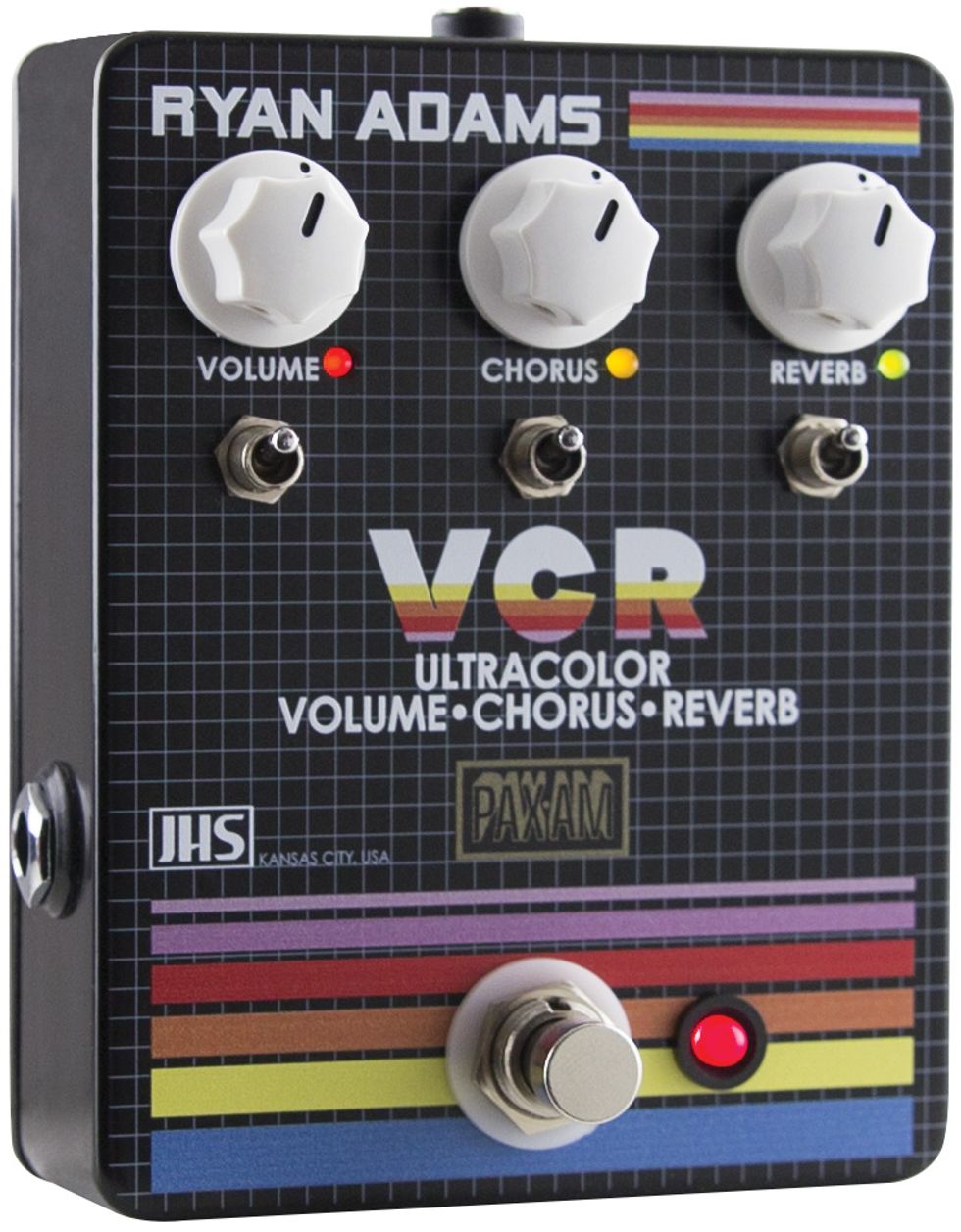Fender Jazzmaster and Fender Vibro Champ
Various chorus, reverb and volume adjusted in real time.
At a glance, the JHS VCR (that’s volume, chorus, and reverb, if your decoder ring is on the fritz) looks pretty specialized. And the fact that it’s a signature pedal designed with Ryan Adams certainly suggests that it caters to a very particular and individual set of needs.
But a stompbox with a muscular clean-to-dirty boost, a Boss CE-2-inspired chorus, and a splashy digital reverb simulation could also be the equivalent of what many practical players would call a smart, streamlined pedalboard. With a tweak here and there, the VCR can deliver everything from variations on SRV’s Vibratone plus TS-9 tones to Johnny Marr’s swirling, punchy jangle. So while it might look like a vanity project, the VCR is, in fact, a colorful chameleon and a fine tool for coping with random backlines or making small amps sound big in the studio.
enormous in a studio.
Ups, Downs, and Straight-Aheads
The VCR control scheme is streamlined. There’s a bypass footswitch, a dedicated toggle to turn each effect on or off, and a single knob to alter the intensity of each effect. The chorus knob serves two functions: In the counterclockwise direction, it increases depth while reducing speed. In the opposite direction, modulations get faster with less waveform intensity. There’s also a small slider switch on top of the pedal that works like a bass-cut filter.
The three-knobs-and-toggles setup means you’ll have to commit to your sound for the duration of a song, bend down to toggle an effect on the fly, or nudge a switch or knob with your foot. It’s limiting in some respects, but as we’ll find out, many settings on the JHS are excellent set-and-forget configurations.
Ratings
Pros:
Mellow-to-immersive ’80s colors and more in a single, streamlined stompbox. Effective clean boost. Nice reverb.
Cons:
Control layout is limiting if you want to switch effects on the fly. Expensive.
Tones:
Ease of Use:
Build/Design:
Value:
Street:
$269
JHS VCR
jhspedals.com
Wide-Open Spaces and Wiggly Ways
Though it’s hard to resist slathering chorus all over everything right out of the gate, the simple combo of boost and reverb reveals much about the pedal’s utility. The reverb is ostensibly a hall reverb simulation, but has some of the clanging, almost metallic overtones of spring reverb. This reverb’s tone profile is a great match for the boost, which stays clean through much of its range, adding volume and low-mid body until it begins to growl right around the 2 o’clock setting (depending on your amp). The two effects together make little amps sound enormous in a studio—or on a stage, with ample sound reinforcement. There’s a lot of extra push in this boost, and a lot of headroom as well.
The boost and reverb are a great match for bigger amps, too. The boost/reverb combination added purring, low-gain overdrive tone to an otherwise clean silverface Bassman. And the low gain thrust and low-mid body is an almost mellowing companion to spiky Brit-style amps.
The chorus is inspired in part by the Boss CE-2—a unit respected for its subtle-to-surreal modulation colors. And though you lose some tone-shaping control with the single-knob configuration, the opposing curves of rate and waveform intensity are plotted nicely. The most recognizably classic CE-2-style tones happen in the middle third of the chorus control’s range. And when mated to reverb and boost settings in the same regions, the pedal serves up the ’80s-informed sounds hinted at in the name and graphics. Whether you love or hate these tones, the VCR offers a very rich and immersive take on the recipe.
The VCR can get muddy if you advance any two controls into their highest reaches. And it’s here that the bass-cut slider switch can be an effective ally. In general though, the best fix for these muddier tones is to ease back on the reverb and boost until they match your pickups and amp.
The Verdict
There’s an appealing practicality to the VCR—especially when you imagine it as the one and only pedal you bring to a gig. Difficulty in switching between effects mid-song is the principal shortcoming. There’s also the issue of the $269 price, which isn’t bad if you consider the cost of three quality pedals purchased independently, but less appealing if you consider that the VCR lacks the switching flexibility of three independent pedals. But if you’re a set-and-forget player that uses these three effects with regularity, Ryan Adam’s VCR could be the smartest money you drop all year.















![Rig Rundown: Russian Circles’ Mike Sullivan [2025]](https://www.premierguitar.com/media-library/youtube.jpg?id=62303631&width=1245&height=700&quality=70&coordinates=0%2C0%2C0%2C0)









